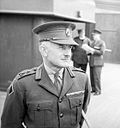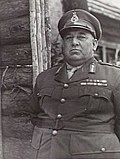

This is the complete order of battle of Allied and Japanese forces during the Borneo campaign of 1945. As the campaign was fought in three geographically separate areas and the same air and naval units supported more than one of these battles the order of battle is split into the three areas.
Contents
- Summary order of battle
- Allied forces
- Japanese forces
- Tarakan (May - June 1945)
- Allied units ("Oboe One Force")
- Japanese units
- Balikpapan (July 1945)
- Allied units ("Oboe Two Force")
- Japanese units 2
- Notes
- References
- Bibliography
- Web
- External links
As it turned out these operations were different from those that had gone before. The minefields were heavier and, for the first time in any Pacific campaign, man-made obstacles had been laid off the beaches.
— Daniel E. Barbey (USN, ret.), MacArthur's Amphibious Navy (1969), p. 314












